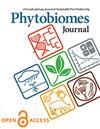Getting to the root of tree soil microbiome sampling
IF 3.3
3区 生物学
Q2 MICROBIOLOGY
引用次数: 0
Abstract
Microbiomes play critical roles in host functioning and therefore there is increasing interest in the microbiome assembly of plants. However, sampling strategies for long-lived perennial trees need to be standardised to produce robust data that accurately represents the microbiome over time. This issue is currently unresolved because there is little evidence indicating which portion of perennial tree species (e.g., root region or surrounding soil) is the best to sample to produce the most accurate measure of microbiome communities. Our aim was to sample different compartments of a plant’s belowground microbiome to identify the optimal sampling strategy to account for the microbial community present. We found that the structure of the microbial community depends most strongly on the environment (site) and compartment of sample collected (bulk soil, rhizosphere, or rhizoplane), rather than the depth or cardinal direction of the sample. We also found that the microbial community increased in diversity with increased distance from the tree within the rhizoplane and rhizosphere. The data presented here provides systematic evidence for a pragmatic and robust sampling regime that was tested and validated across different environments and soil types while controlling for host genotype. This sampling regime will enable effective partitioning of root compartments when studying the microbiome associated with perennial tree species, allowing targeted questions about the microbiome to be explored with greater accuracy.进入树根土壤微生物组采样
微生物组在宿主功能中起着至关重要的作用,因此人们对植物微生物组组装的兴趣越来越大。然而,长寿命多年生树木的采样策略需要标准化,以产生准确代表微生物组随时间变化的可靠数据。这个问题目前尚未解决,因为几乎没有证据表明多年生树种的哪一部分(例如,根区或周围土壤)是最好的采样,以产生最准确的微生物群落测量。我们的目标是对植物地下微生物组的不同隔间进行采样,以确定最佳采样策略,以解释当前的微生物群落。我们发现,微生物群落的结构在很大程度上取决于环境(地点)和样品采集区(大块土壤、根际或根面),而不是样品的深度或基本方向。根际和根际微生物群落多样性随离树距离的增加而增加。本文提供的数据为在控制宿主基因型的同时,在不同环境和土壤类型中测试和验证的实用和稳健的抽样制度提供了系统证据。在研究与多年生树种相关的微生物组时,这种采样制度将使根室的有效分配成为可能,从而可以更准确地探索有关微生物组的针对性问题。
本文章由计算机程序翻译,如有差异,请以英文原文为准。
求助全文
约1分钟内获得全文
求助全文

 求助内容:
求助内容: 应助结果提醒方式:
应助结果提醒方式:


